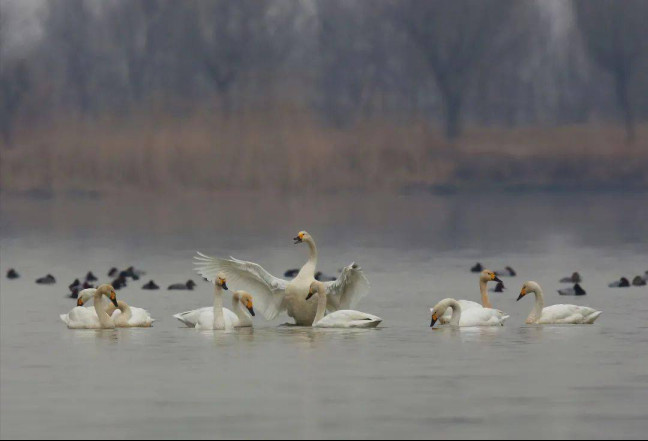By Wu Shaomin, Gong Xiangjuan, People's Daily

Photo shows birds in the Qilihai Wetland, north China's Tianjin municipality. (Photo courtesy of the management committee of the Qilihai Wetland nature reserve)
The Qilihai Wetland in north China's Tianjin municipality is an important stopover site for migratory birds. It is also a vital part of the ecological resources in north China’s Beijing-Tianjin-Hebei region.
In summer, a mixed fragrance of various flowers and herbs can be smelled in the moist air in the wetland. Through comprehensive environmental treatment and multiple protection measures, the Qilihai Wetland has made positive and remarkable progress in bird protection over the recent years, and is seeing more and more bird species.
The natural wetland is a major stopover site for birds migrating from East Asia to the western part of Australia. In the past migratory season, over 400,000 migratory birds rested in the wetland.
It’s unusual to see such a wetland that is only about 30 kilometers away from downtown Tianjin and 100 kilometers away from the Chinese capital Beijing.
Five years ago, the wetland was unattractive for migratory birds, when the river upstream of the wetland went empty and immoderate urban expansion had led to a series of environmental challenges.
To restore the ecology in the wetland, Ninghe district of Tianjin made a plan for ecological conservation in 2017 and started implementing a series of projects to regulate water resources, restore reed beds and protect bird species.
The district government put 130,000 mu (8,667 hectares) of weed beds, water and land surface under protection, dredged 37 kilometers of river courses, restored 20,000 mu of vegetation and expanded the water area in the wetland by over 50 percent.
As a result, the Qilihai Wetland has gradually recovered its biodiversity. There are currently 258 bird species in the wetland, up from 182 ten years ago. The number of migratory birds making stopovers in the wetland also increased from around 200,000 to 500,000 a year.
According to Yu Zenghui, a consultant of the management committee of the Qilihai Wetland nature reserve, reed parrotbills, dubbed the "panda of birds," have been observed in the wetland after a decade of absence.
"Some migratory birds even become residents in the wetland," Yu said.
To provide a better habitat for the birds, the management committee of the Qilihai Wetland nature reserve has built and reconstructed 100 bird islands, to form a "lake-island" ecological layout. Through scientific control of the water level, they were divided into a 15,000-mu shallow area and a 13,000-mu deep area according to different habits of birds.
Oriental white stork, herons, and egrets can be seen in shallows of varying heights, while the deep area is more suitable for swans, gulls, wild ducks and cormorants to rest.
To ensure ecological security in the wetland, the management committee circled the wetland with 49-kilometer fencing and installed a video surveillance system. Rangers are on daily patrols to discover, stop and deal with illegal practices such as bird-catching and damage to the wetland.
Apart from the daily patrols, cameras are installed at important sites in the wetland and there are staff members on duty watching the surveillance video 24 hours a day. Besides, a drone is employed to protect the safety of the birds in the wetland.
Han Kewu, head of the ranger team in the Qilihai Wetland nature reserve, discovered an injured oriental white stork on a patrol mission in the winter of 2020. The bird was later sent to a rescue station and released after it recovered.
"We used to be very excited seeing rare birds such as oriental white stork, but now it’s not a surprise as they are seen more and more frequently here," Han told People's Daily.
Since October 2020, over 5,000 oriental white storks have been seen migrating across Tianjin.
In summer, a mixed fragrance of various flowers and herbs can be smelled in the moist air in the wetland. Through comprehensive environmental treatment and multiple protection measures, the Qilihai Wetland has made positive and remarkable progress in bird protection over the recent years, and is seeing more and more bird species.
The natural wetland is a major stopover site for birds migrating from East Asia to the western part of Australia. In the past migratory season, over 400,000 migratory birds rested in the wetland.
It’s unusual to see such a wetland that is only about 30 kilometers away from downtown Tianjin and 100 kilometers away from the Chinese capital Beijing.
Five years ago, the wetland was unattractive for migratory birds, when the river upstream of the wetland went empty and immoderate urban expansion had led to a series of environmental challenges.
To restore the ecology in the wetland, Ninghe district of Tianjin made a plan for ecological conservation in 2017 and started implementing a series of projects to regulate water resources, restore reed beds and protect bird species.
The district government put 130,000 mu (8,667 hectares) of weed beds, water and land surface under protection, dredged 37 kilometers of river courses, restored 20,000 mu of vegetation and expanded the water area in the wetland by over 50 percent.
As a result, the Qilihai Wetland has gradually recovered its biodiversity. There are currently 258 bird species in the wetland, up from 182 ten years ago. The number of migratory birds making stopovers in the wetland also increased from around 200,000 to 500,000 a year.
According to Yu Zenghui, a consultant of the management committee of the Qilihai Wetland nature reserve, reed parrotbills, dubbed the "panda of birds," have been observed in the wetland after a decade of absence.
"Some migratory birds even become residents in the wetland," Yu said.
To provide a better habitat for the birds, the management committee of the Qilihai Wetland nature reserve has built and reconstructed 100 bird islands, to form a "lake-island" ecological layout. Through scientific control of the water level, they were divided into a 15,000-mu shallow area and a 13,000-mu deep area according to different habits of birds.
Oriental white stork, herons, and egrets can be seen in shallows of varying heights, while the deep area is more suitable for swans, gulls, wild ducks and cormorants to rest.
To ensure ecological security in the wetland, the management committee circled the wetland with 49-kilometer fencing and installed a video surveillance system. Rangers are on daily patrols to discover, stop and deal with illegal practices such as bird-catching and damage to the wetland.
Apart from the daily patrols, cameras are installed at important sites in the wetland and there are staff members on duty watching the surveillance video 24 hours a day. Besides, a drone is employed to protect the safety of the birds in the wetland.
Han Kewu, head of the ranger team in the Qilihai Wetland nature reserve, discovered an injured oriental white stork on a patrol mission in the winter of 2020. The bird was later sent to a rescue station and released after it recovered.
"We used to be very excited seeing rare birds such as oriental white stork, but now it’s not a surprise as they are seen more and more frequently here," Han told People's Daily.
Since October 2020, over 5,000 oriental white storks have been seen migrating across Tianjin.
 Menu
Menu
 Wetland in Tianjin sees improved environment for bird species
Wetland in Tianjin sees improved environment for bird species
















